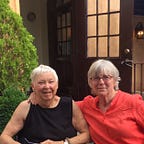A lifetime of visible and invisible disabilities
ESSAY | Two friends share their story
Essay by Cornell University chair, Valerie Bunce and University of Maryland professor emerita, Gay Gullickson. The views expressed are the opinions of the authors.
We are both women. We have had long careers in academia. We have been disabled since childhood. Gay had polio as a child and relies on a wheelchair, whereas Val inherited a progressive hearing loss and has worn hearing aids since she was a teenager.
As we near the end of our academic careers, we realize that we have had some experiences that we would like to share with the (temporarily) able-bodied world.
Over the course of our 40-year friendship, we have learned that disabled people have a lot in common. We are reminded daily that we are a minority.
The good news is that we have learned to appreciate all the ways in which people differ from one another.
The bad news is that we often feel that we are a forgotten minority. We frequently need to remind people, despite our dislike of calling further attention to ourselves, that we, like all minorities, want respect, representation and rights.
All of us in the disabled community also share a daily life that is more difficult, tiring and prone to personal embarrassments than the daily experiences of able-bodied people. We struggle for full access, whether it is to jobs, buildings or the conversations going on around us.
We are also ambivalent about whether we want to pass for being able-bodied or simply accept who we are. Just as Gay loved the invention of drive-in restaurants and banks, because they gave her easier access and, by being in a car, made her look like everyone else, so Val has loved the equalizing effects of using email and texting to communicate with other people. As we have aged, we have also become more acceptant of our limitations, aided in that process by witnessing the struggles and achievements of other minorities in our lifetime and the passage of the Americans with Disabilities Act.
What has also helped us feel more comfortable is that aging has leveled the playing field. There are a lot more people like us than there used to be, including some of our once able-bodied friends.
A final experience we share is that people can be very helpful. Gay recently broke her leg and received exceedingly generous help from friends and neighbors. Strangers, in contrast, can be uncomfortable around us. They are not sure how to behave — which can prompt them to act in strange ways. Some people ignore us, which we dislike, because we do not want being different to mean that we disappear. Other people feel compelled to point out some advantages to being disabled. They tell Gay that she is lucky to have parking places reserved for her and Val that it must be great to miss the nasty and stupid comments people make.
We have also had some different experiences in the world, because Gay’s disability is visible and Val’s is invisible. For Gay, there are the embarrassments associated with looking different. While virtually everyone, except very young children and President Trump, knows that it is unacceptable to make fun of someone whose body does not look the same or work the same as that of other people, there is nonetheless a strong tendency of many people to sneak a second look at someone who has a visible handicap as though they need to nail down what is exactly “off” about this person.
As the president has reminded us many times, how people look matters a lot and, in his case unfortunately, gives him a license to react — whether that takes the form of imitating a disabled reporter, making nasty comments about the weight of a beauty contestant, or engaging in sexually predatory behavior with women he codes as beautiful.
Invisible handicaps have different costs. Because their disability cannot be seen, people with hidden handicaps, such as hearing impairment, must inform other people about their limitations and make the case for accommodation. These requests are often met, however, with skepticism. There is no visible proof of a handicap; hearing aids are assumed (wrongly) to level the playing field; and misunderstanding what has been said or failure to hear at all are often attributed to inattention, rudeness and even stupidity. Hearing impairment is also an “inconsistent” disability. Whereas Gay cannot walk under any circumstances, Val can sometimes hear. For these reasons, when a disability is invisible, it easily becomes questionable.
